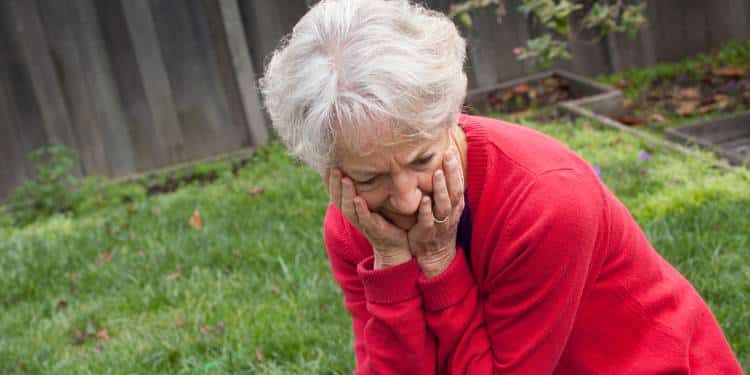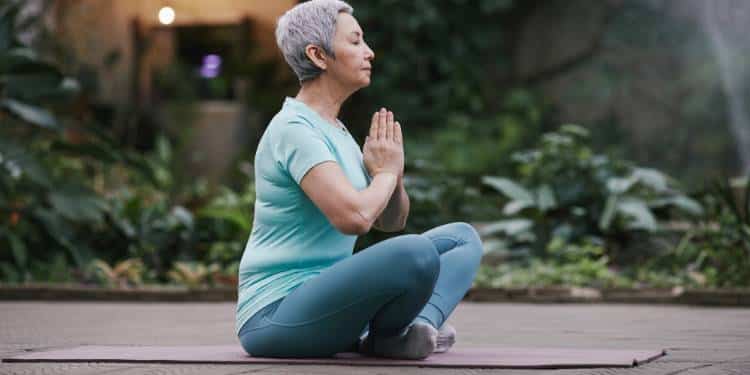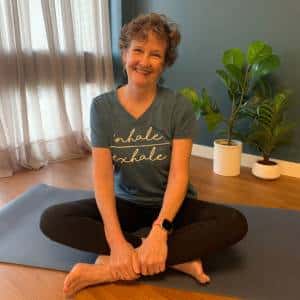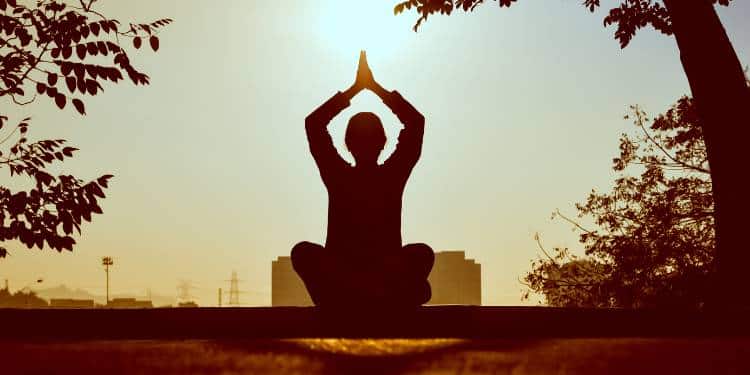by Nancy Watson
Yoga is trendy among the 50Plus crowd, and for good reason. Most yoga classes include activities for stretching and strengthening, offer balance challenges, and incorporate mindfulness and relaxation techniques. The word “yoga” means “union” – of body, mind, and spirit. The practice provides movement for the body and stillness for the mind, instilling a sense of calm and well-being in addition to the physical benefits. If you don’t already practice yoga yourself, you probably know someone who does who will attest to its many benefits.
What may be new to you however is the concept of yoga as a tool for managing symptoms of grief. By a certain point in life, everyone will inevitably experience some type of devastating loss. It may be the death of a loved one, a broken relationship, a loss of health, or the ending of a career. Grief is a natural and complex response to loss, so it follows that everyone will also experience grief at some point.

What is Yoga for Grief?
In a nutshell, yoga for grief is the practice of using yoga as a therapeutic tool to cope with the emotional pain and sorrow associated with loss. With its combination of physical postures (asanas), breath control (pranayama), meditation, and mindfulness, yoga can offer a holistic approach to addressing grief.
Sadly, we live in a “grief illiterate” society where active grieving frequently makes others uncomfortable. People don’t know what to say to grieving friends or relatives, so they often say nothing at all. The bereaved are then left to deal with intense emotions on their own and in silence. People may continue to experience the intense feelings that accompany grief long after they cease to look outwardly sad.
Grief can manifest in various ways that affect our mental and physical health. When I experienced a traumatic loss in 2019, yoga – along with my yoga community – saved me. I’ve practiced yoga for almost 25 years and am a certified instructor. I know that yoga, in all its forms, has great potential as a means to help people cope with traumatic grief, as it did for me. Yoga instructors though, are not generally trained specifically in bereavement. When I learned about the Compassionate Bereavement Care Yoga program, I was immediately drawn to it, in large part due to my own grieving journey. This program teaches yoga instructors to work even more effectively with the bereaved in a way that minimizes any potential risk or harm.
Why do Yoga for Grief and Loss?
Although many people think of yoga as a purely physical exercise, the true purpose of yoga is to help quiet the churning thoughts in our heads. Meditation can help quiet your mind, but this can also occur through movement. We may feel numb by the shock of loss, or it can seem that strong emotions are lodged in our bodies. As we flow through poses, we become aware of the tension we hold in our muscles and the emotions that simmer beneath the surface. These feelings of grief and loss can leave us feeling fragile, unmoored, and adrift. For many, finding a physical way to anchor themselves in the present moment can feel like a lifeline.

How is Yoga for Grief and Loss Different From a “Regular” Yoga Class?
While every yoga class and teacher is a bit different, there are some constants. A “regular” yoga class starts with some stillness and mindfulness to draw your attention and focus inward. After some gentle waking-up movements, the class progresses to larger and possibly more challenging movements. The end of class includes a five to seven-minute period of rest, or savasana. In both types of classes, participants leave the room feeling relaxed and energized, with a clearer mind and looser muscles. Generally, the instructor educates participants at some point during the class about yoga philosophy to help them understand how a yoga practices help both physically and emotionally.
A class focusing on yoga for grief contains all of these components, with some additions. There is usually a longer guided meditation, a time for journaling, and possibly some time for participants to share a little about the loved one they lost. Many feel it’s helpful just to be in a room with other people going through similar feelings of loss.
Mindfulness and Grief
Mindfulness is a very important component of yoga, especially for yoga that focuses on grief and loss. A mindfulness practice is the art of being fully present in the moment, completely focused on what is happening at that moment. In grief, our minds are often pulled into the past, reliving memories, wallowing in regret, or “awfulizing” an uncertain future. Through deep breathing and meditation, we learn to witness and observe our thoughts and feelings without becoming overwhelmed by them. This mindfulness practice allows us to experience compassionate, non-judgmental awareness and learn to calm our minds even amid emotional turmoil.
Mindfulness is a skill that develops over time and gradually equips us with tools for coping with difficult moments. By staying present and aware, we can learn to respond to challenges in a more intentional and measured way. And while it may not eliminate your pain, it can help you find moments of peace amid the challenges in your grieving journey.
The Bottom Line
The practice of yoga for grief can be a gentle and supportive companion on your journey toward life after a profound loss. It is not a fix for the pain from your loss, but it offers support that tends to the body, the mind, and the spirit to bring you a bit of ease amidst your sadness. As a tangible practice that you can do by yourself and for yourself, yoga encourages you to be an active participant in your own grief process. There is something ineffable about yoga, and each participant will likely get something different from a class – but it provides what each person needs at that very moment.
Please note that grief is a deeply personal experience, and different people may find different approaches helpful. Yoga is not meant to replace support from mental health professionals or support groups if needed to help cope with profound grief; it’s intended to be complementary.

FAQs About Yoga for Grief
Here are some commonly asked questions people ask about yoga for grief and loss, along with the answers.
How Can Yoga Help with Grief?
Yoga offers a holistic approach to help with grief. It addresses physical tension, promotes relaxation, offers breath awareness for emotional regulation, encourages mindfulness, and creates a supportive community environment. Here are some additional details related to how yoga helps with grief.
Physical Release: As grief often manifests physically, you may find yourself experiencing tension and tightness in your body. Yoga postures and gentle movements help release physical tension, promoting relaxation and easing your body’s response to stress.
Breath Awareness: Conscious breathing, or pranayama, helps you connect with your breath, promoting a sense of calm and providing a tool to manage your emotions.
Mindfulness and Meditation: Yoga encourages present-moment awareness and mindfulness, which can be particularly helpful for those grieving. Meditation practices provide a space for reflection, acceptance, and processing of emotions.
Emotional Release: Yoga poses and sequences may help release emotional energy stored in your body. This can create a safe place to express and explore your emotions.
Community Support: Participating in group yoga classes or workshops focused on grief often provides a sense of community and shared understanding. It allows you to connect with others who are also navigating the challenges of grief.
Self-Compassion: Yoga philosophy emphasizes self-compassion and acceptance. This can be valuable when experiencing grief, helping you to be kind to yourself as you navigate the grief process.
Are there specific yoga poses for grief?
While there are no specific poses exclusively for grief, certain poses may be particularly beneficial, such as gentle stretches, heart-opening poses, and restorative poses. The emphasis is on creating a safe space for emotional release and physical relaxation.
Is yoga a replacement for professional grief counseling?
No, yoga should be seen as a complementary approach to grief work. It can be used in conjunction with professional grief counseling, therapy, or support groups to provide a comprehensive and well-rounded support system.
How often should I practice yoga for grief?
The frequency of your yoga practice for grief can vary depending on your individual needs and preferences. Starting with a couple of sessions per week and gradually increasing based on comfort and availability is a good approach. Consistency is often more important than frequency.
Are there specific breathing exercises for grief?
Yes, various pranayama (breathwork) techniques can be beneficial for managing grief. Deep belly breathing, alternate nostril breathing (Nadi Shodhana), and calming breath exercises can help regulate emotions and promote a sense of calm.
Is yoga for grief a religious practice?
While yoga has roots in various spiritual traditions, modern yoga classes primarily focus on the physical and mental aspects. This practice is therefore helpful to people of all faiths or those with no religious affiliation. The emphasis is on holistic well-being and self-care.
About the Author: Nancy Watson
 Nancy is a longtime yoga practitioner and yoga teacher. She is currently the only Certified Bereavement Care Yoga (CBC-Y) teacher in the northeast Texas area. Learn more on her website.
Nancy is a longtime yoga practitioner and yoga teacher. She is currently the only Certified Bereavement Care Yoga (CBC-Y) teacher in the northeast Texas area. Learn more on her website.
“One day you will tell your story and how you got through it. That story will be a part of someone else’s survival guide.”










